EDUCATION
Measuring and Recipe Educational IEP Goal: Learning Practically

Creating a measuring and recipe educational IEP goal is a vital component of special education that empowers students with real-life functional skills. This goal supports learners in developing practical knowledge of measurement, comprehension of recipes, and the ability to follow multi-step directions. Integrating this skillset into a student’s Individualized Education Program (IEP) nurtures independence, strengthens academic achievement, and prepares them for life beyond the classroom.
Understanding the Importance of Measuring and Recipe Educational IEP Goals
For many students, especially those with cognitive or developmental disabilities, academic success isn’t solely about reading, writing, or mathematics. Life skills—such as understanding measurements in recipes—can significantly affect a student’s ability to function independently. The measuring and recipe educational IEP goal bridges academic standards with practical living skills, giving students the tools they need to cook, bake, shop, and thrive in their home or vocational settings.
Aligning Goals with Individual Needs
What Makes a Good IEP Goal?
A well-crafted IEP goal is:
- Specific: Clear in what skill will be developed.
- Measurable: Allows educators to track progress.
- Attainable: Realistic for the student’s current ability.
- Relevant: Important for the student’s life.
- Time-bound: Set within a defined period.
Why Focus on Measuring and Recipe Skills?
These goals align with multiple educational standards:
- Math Skills: Units of measure, fractions, volume.
- Reading Comprehension: Understanding multi-step directions.
- Fine Motor Skills: Pouring, cutting, mixing.
- Executive Functioning: Planning, sequencing, and organization.
By blending these elements, the measuring and recipe educational IEP goal becomes a holistic tool that not only nurtures learning but builds life confidence.
Sample IEP Goal for Measuring and Recipe Skills
Here’s an example of a SMART IEP goal:
“By the end of the IEP period, the student will correctly measure dry and liquid ingredients using standard kitchen tools and follow a 5-step recipe with 80% accuracy in 4 out of 5 trials, as measured by teacher observation and a performance checklist.”
This example integrates measurable outcomes, real-life skills, and allows for flexibility in instructional strategies.
Core Components of Teaching Measuring and Recipe Skills
Ingredient Measurement
One of the foundational aspects of recipe-based IEP goals is teaching students how to:
- Identify and use measuring cups and spoons.
- Distinguish between dry and liquid ingredients.
- Use kitchen scales when needed.
Activities like practicing with flour, sugar, or water can help reinforce consistency and accuracy.
Following a Recipe
Understanding a recipe involves:
- Reading or listening to directions.
- Organizing ingredients and tools.
- Executing steps in proper sequence.
- Cleaning up after preparation.
These tasks develop not just comprehension but also responsibility.
Using Visual Supports
Students benefit greatly from:
- Picture recipes with step-by-step illustrations.
- Color-coded measuring tools.
- Timers to manage steps.
These accommodations enhance engagement and reduce anxiety, especially for students with processing challenges.
Emotional and Psychological Impact
Students often experience frustration when they feel disconnected from their academic tasks. Teaching through cooking transforms learning into something tangible and enjoyable. There’s an emotional satisfaction in completing a recipe—a feeling of accomplishment that builds self-worth.
Furthermore, cooking and measuring can be calming, serving as an outlet for emotional regulation. By integrating these tasks into the IEP, educators address not only academic but also emotional needs.
Integrating Measuring and Recipe Goals into Different Environments
Classroom Settings
Special education classrooms can simulate kitchens or use portable cooking tools for instruction. Recipe lessons can tie into math, reading, and science.
Home Collaboration
Parents and caregivers can be active participants. Sending home simplified recipes and ingredient kits can reinforce skills and foster family engagement.
Vocational Training
For older students, measuring and recipe goals serve as a foundation for jobs in:
- Food services
- Hospitality
- Retail (e.g., grocery stores)
These goals open vocational doors and create a path to employment independence.
Challenges and Solutions
| Challenge | Solution |
| Students struggle with attention | Break recipes into short, manageable steps with visuals |
| Difficulty in understanding units | Teach using real objects and hands-on practice |
| Poor fine motor skills | Use adapted kitchen tools (e.g., grip-handled cups, non-slip mats) |
| Language processing issues | Pair text instructions with images or videos |
| Limited generalization | Practice in multiple environments (school, home, community) |
Understanding these hurdles and addressing them with compassion helps ensure each student’s success.
Comparison Table: Measuring and Recipe Educational IEP Goal Features
| Feature | Cost | Efficiency | Ease of Use | Scalability | Benefits |
| Traditional Classroom Tools | Low | Moderate | Easy with training | Moderate | Enhances group participation |
| Picture Recipes | Low | High | Very Easy | High | Great for visual learners |
| Digital Apps | Moderate | Very High | Easy | Very High | Tracks progress, offers accessibility |
| Home-based Learning Kits | Moderate | Moderate | Easy for parents | Low | Strengthens school-home connection |
| Vocational Integration Programs | High | Very High | Moderate | Low | Prepares for real-world jobs |
Each method brings unique value, allowing educators to customize the IEP strategy based on resources and student needs.
Assessing Progress on Measuring and Recipe Goals
Performance-Based Assessment
Students should be observed and scored during actual cooking or measuring sessions using rubrics or checklists that assess:
- Accuracy of measurement
- Sequencing of recipe steps
- Understanding of vocabulary (e.g., tsp, tbsp, mix, bake)
Data Collection
IEP documentation must include:
- Date and frequency of observations
- Percentage of independence vs. prompted behavior
- Anecdotal notes for context
This thorough evaluation allows for data-driven instruction that adjusts to the student’s evolving capabilities.
Expert-Recommended Strategies
While each student’s learning journey is unique, educators can implement best practices:
- Use of multisensory instruction to engage all learning styles.
- Positive reinforcement to encourage participation and risk-taking.
- Frequent repetition and generalization to solidify skills in new contexts.
These techniques, informed by years of classroom experience, ensure that measuring and recipe educational IEP goals are not just met but meaningfully mastered.
Long-Term Impact
Integrating a measuring and recipe educational IEP goal into a student’s plan sets the stage for a lifetime of self-sufficiency. Skills acquired through these lessons extend far beyond the kitchen. They cultivate:
- Independence in daily routines
- Confidence in social and vocational settings
- An increased sense of self-worth and purpose
In a world where academic pressure often overshadows life skills, this approach returns balance, dignity, and direction to learners with diverse needs.
Conclusion
The measuring and recipe educational IEP goal is more than an instructional target—it is a roadmap to independence, resilience, and success. By teaching students how to measure ingredients and follow recipes, educators are fostering not just practical skills but long-term empowerment. Through structured lessons, emotional engagement, family involvement, and vocational relevance, this goal offers measurable progress and immeasurable impact.
FAQs
What is a measuring and recipe educational IEP goal?
A measuring and recipe educational IEP goal is a specific learning target included in an Individualized Education Program to help students develop life skills through cooking, including accurate measurement, recipe comprehension, and step-by-step task execution.
Who benefits from this type of IEP goal?
Students with intellectual, developmental, or learning disabilities benefit the most. These goals help improve their math, literacy, motor, and executive functioning skills while preparing them for independent or semi-independent living.
How can I measure progress on this goal?
Progress can be tracked using performance-based assessments, checklists, observation logs, and data collection on the student’s ability to measure accurately, follow recipe steps, and work with reduced prompts over time.
Can this goal be taught at home?
Yes, parents and caregivers can reinforce this goal by engaging students in home-based cooking activities. Simplified recipes, visual instructions, and consistent practice help in transferring skills from school to home.
What are some tools that support teaching these skills?
Helpful tools include picture-based recipes, color-coded measuring tools, adaptive kitchen devices, cooking apps, and video demonstrations. These make the learning process more accessible and enjoyable.
How do measuring and recipe skills support employment readiness?
These skills are essential in many job sectors like hospitality, food service, and caregiving. Mastery of cooking-related tasks prepares students for vocational training, internships, or employment opportunities in community settings.
EDUCATION
How Has the Boston Population 2024 Changed?
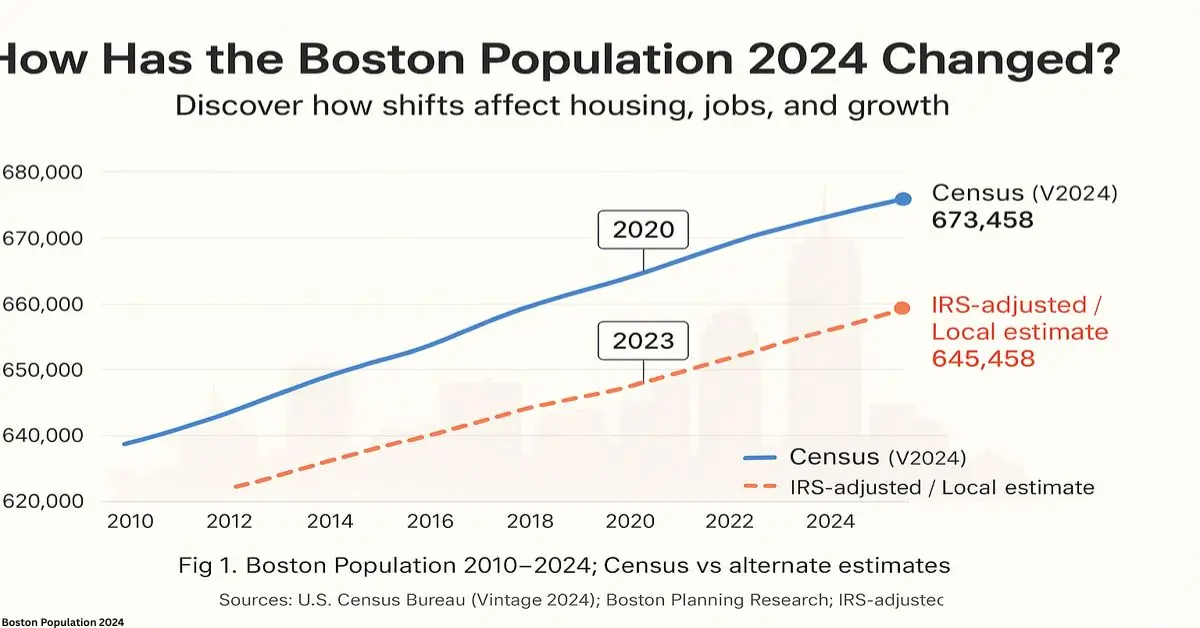
Boston population 2024 is more than just a statistic, it drives housing markets, business plans, and city policy. Whether you’re planning a project, moving here, or studying city growth, the latest numbers tell a deeper story.
Quick Answer: Boston’s 2024 Population
Boston’s population in 2024 is 673,458 according to the U.S. Census Bureau’s latest estimates. The Boston metro area has 5,025,517 residents, making it the 11th largest in the U.S.
What Counts as “Boston”?
Boston city refers to the official city limits. The Boston metro area includes nearby cities and towns where people live, work, and commute together. The Census is the official national count every 10 years, while annual estimates track population changes in between.
City vs. Metro: The 2024 Picture
- City population: 673,458 (down 0.3% from 2020’s 675,647)
- Metro area population: 5,025,517 (up 1.2% from 2023)
- Population density: 13,841 per sq. mile over 48.4 sq. miles
- Rank: 25th largest U.S. city, 11th largest metro
Growth Trends Since 1950
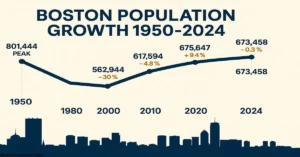
- 1950: 801,444 (historical peak)
- 1980: 562,994 (30% drop from 1950)
- 2000: 589,141
- 2010: 617,594 (+4.8%)
- 2020: 675,647 (+9.4%)
- 2024: 673,458 (-0.3%)
The city’s population dipped slightly since 2020, but the metro area grew faster than any in the Northeast or Midwest from 2023 to 2024.
What’s Driving the Numbers?
International migration is the key driver of Boston’s population growth. In 2024, Massachusetts gained 90,217 net international migrants but lost 27,480 domestic residents, meaning foreign-born arrivals offset local departures.
Boston’s Demographic Makeup (2024 Estimates)
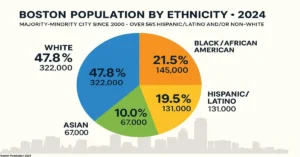
| Category | % of Population | Approx. Number |
| White | 47.8% | 322,000 |
| Black/African American | 21.5% | 145,000 |
| Hispanic/Latino | 19.5% | 131,000 |
| Asian | 10.0% | 67,000 |
Majority-minority since 2000: Over 56% of residents are Hispanic/Latino and/or non-White.
Neighborhood Variations
- East Boston: Nearly 50% foreign-born
- South Boston: 76.9% White
- Highest growth areas: Charlestown, South Boston Waterfront, Allston
- Student influence: 159,000+ enrolled in city institutions, making counts tricky
Controversies in the Count
City officials claim the 2020 Census undercounted Boston by 25,000+ people due to pandemic disruptions and difficulty counting mobile young adults. Researchers suggest the true 2020 population was closer to 699,893.
Expert Voices:
- Robert L. Santos, U.S. Census Bureau Director: “The quality of the 2020 Census count is consistent with recent censuses,” but noted undercount issues among certain groups.
- Michelle Wu, Boston Mayor: “Our population was undercounted…this impacts funding and representation.”
- Peter Ciurczak, Boston Indicators: “Immigration has been saving our butts.”
Boston vs. Other Cities in 2024
| City | 2024 Population | Growth Rate 2023–2024 |
| Boston, MA | 673,458 | -0.3% |
| New York, NY | 8,335,897 | +0.2% |
| Philadelphia, PA | 1,550,540 | -0.1% |
| Austin, TX | 983,350 | +2.1% |
Boston’s city growth lags Sun Belt metros but outpaces many Northeast peers in metro growth.
Why This Matters for Housing & Business
- Real estate: Slight city shrinkage, but strong metro growth = suburban demand.
- Policy: Immigration trends will shape the future labor force.
- Infrastructure: Growth strains roads, schools, and utilities.
FAQ’s
Q1: What is Boston population 2024?
Boston has 673,458 people; metro area 5,025,517.
Q2: Is Boston’s population increasing or decreasing?
The city declined 0.3% from 2020; the metro grew 1.2% from 2023 to 2024.
Q3: What drives Boston’s population growth?
Primarily international migration; domestic migration is negative.
Q4: How diverse is Boston?
Over 56% of residents are Hispanic/Latino and/or non-White.
Q5: How does Boston compare to other cities?
It’s the 25th largest U.S. city but ranks 11th in metro size.
Sources:
- U.S. Census Bureau, 2024 Estimates
- Boston Planning and Development Agency
- Boston Indicators Research
EDUCATION
Best States for Teacher Pay vs Cost of Living (2025)
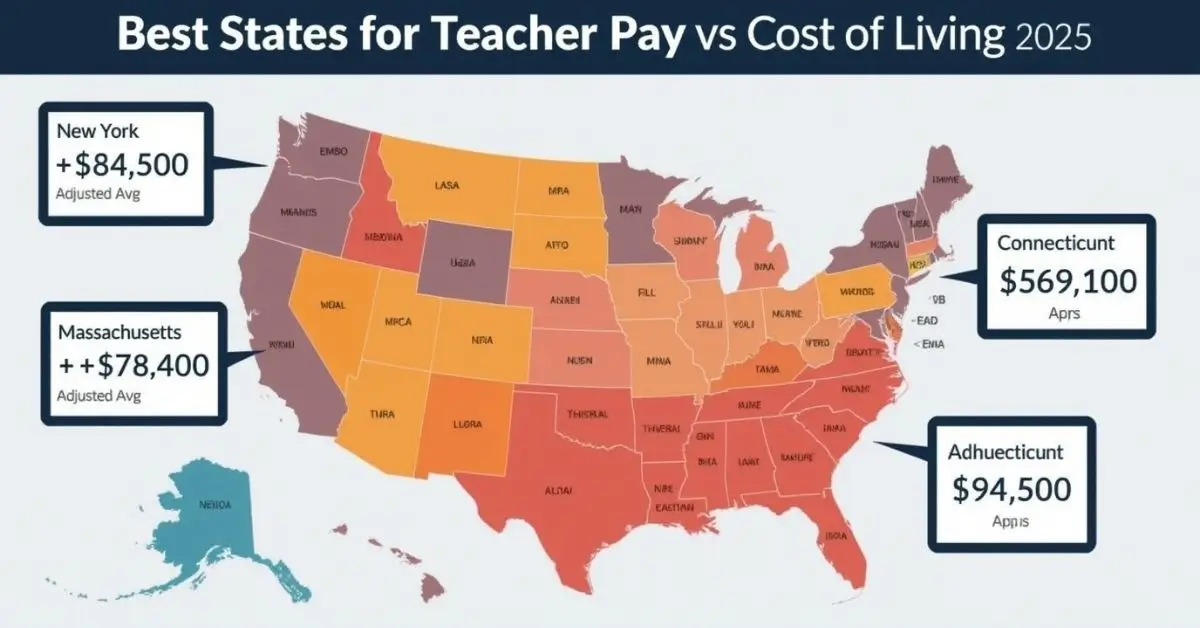
If you’re a teacher, tutor, education student, union leader, or school admin, you’ve probably asked: Where can I earn well and still afford to live comfortably? Great pay doesn’t always mean great value—especially when rent, groceries, and gas eat it all up. We’ve ranked the best states for teacher pay vs cost of living so you can see where your salary works smarter, not harder.
Short Answer
The best states for teacher pay vs cost of living in 2025 are Missouri, Arkansas, North Dakota, Mississippi, and Indiana. These states offer high teacher salaries relative to low housing, food, and utility costs. Teachers in these states keep more of what they earn—and live better on less.
Why Salary Alone Doesn’t Tell the Whole Story
A big paycheck sounds great. But if you’re paying $2,500/month in rent, that $60k salary quickly vanishes.
That’s why we looked at salary-to-cost-of-living ratios, not just raw wages.
Here’s what we analyzed:
- Average teacher salary by state
- 2025 cost of living index
- Adjusted income (real take-home value)
- State benefits, housing affordability, and teacher retention rates
(Source: National Education Association (NEA), U.S. Bureau of Labor Statistics (BLS), and WalletHub cost-of-living data.)
Top 25 States for Teacher Pay vs Cost of Living (2025)
| Rank | State | Avg Teacher Salary | Cost of Living Index | Value Score |
| 1 | Missouri | $52,300 | 87.4 | High |
| 2 | Mississippi | $51,100 | 85.0 | High |
| 3 | Arkansas | $53,200 | 86.7 | High |
| 4 | West Virginia | $52,600 | 87.9 | High |
| 5 | Indiana | $56,900 | 89.1 | High |
| 6 | Iowa | $57,800 | 90.3 | High |
| 7 | Ohio | $59,000 | 91.2 | High |
| 8 | Kentucky | $55,500 | 89.7 | High |
| 9 | Oklahoma | $54,800 | 88.3 | High |
| 10 | North Dakota | $58,200 | 92.1 | Medium |
| 11 | South Dakota | $53,700 | 89.6 | Medium |
| 12 | Louisiana | $54,000 | 90.8 | Medium |
| 13 | Kansas | $55,900 | 91.7 | Medium |
| 14 | Alabama | $56,000 | 92.2 | Medium |
| 15 | Georgia | $58,900 | 93.1 | Medium |
| 16 | Texas | $59,100 | 94.2 | Medium |
| 17 | Tennessee | $57,000 | 92.9 | Medium |
| 18 | New Mexico | $60,300 | 95.4 | Medium |
| 19 | Michigan | $62,000 | 96.3 | Medium |
| 20 | Pennsylvania | $64,200 | 98.5 | Medium |
| 21 | North Carolina | $58,400 | 95.1 | Medium |
| 22 | Florida | $57,800 | 96.7 | Medium |
| 23 | Wisconsin | $63,000 | 98.1 | Medium |
| 24 | Arizona | $60,100 | 97.5 | Medium |
| 25 | Minnesota | $65,000 | 99.2 | Medium |
Top 25 States Complete Details
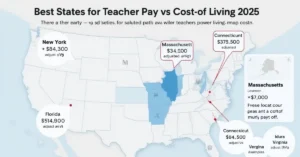
1. Missouri
- Adjusted Salary: High due to low cost of living (COL index: 87.4)
- Housing Costs: Rent is affordable, even in larger cities
- Teacher Retention: Strong teacher community and pension support
- State Incentives: Relocation aid available in rural districts
- Cost Stability: COL has remained stable over the past three years
2. Mississippi
- Adjusted Salary: High relative to extremely low living costs
- Housing Costs: Among the most affordable home prices in the U.S.
- Teacher Retention: Improving with new state-led reforms
- State Incentives: Tax relief and housing help for educators
- Cost Stability: Very low inflation from 2023 to 2025
3. Arkansas
- Adjusted Salary: Offers high value with moderate base pay
- Housing Costs: Consistently below national average
- Teacher Retention: High teacher loyalty in rural communities
- State Incentives: Signing bonuses and student loan forgiveness
- Cost Stability: Minor fluctuations in utilities
4. West Virginia
- Adjusted Salary: Modest pay offset by low living costs
- Housing Costs: Very affordable, especially in small towns
- Teacher Retention: Strong in districts offering local support
- State Incentives: Grants for teachers in underserved schools
- Cost Stability: Largely stable since 2022
5. Indiana
- Adjusted Salary: High when adjusted for COL
- Housing Costs: Competitive in suburban and exurban areas
- Teacher Retention: Better than neighboring states
- State Incentives: Support for continuing education
- Cost Stability: Minor rise in housing; other costs flat
6. Iowa
- Adjusted Salary: Reliable and balanced
- Housing Costs: Home prices remain highly affordable
- Teacher Retention: Strong support systems for educators
- State Incentives: Rural teacher grants and professional development
- Cost Stability: Stable inflation rates
7. Ohio
- Adjusted Salary: Strong, especially in mid-size cities
- Housing Costs: Rent-to-income ratio is favorable
- Teacher Retention: High satisfaction in suburban districts
- State Incentives: Pension-friendly retirement plans
- Cost Stability: Costs have remained steady for three years
8. Kentucky
- Adjusted Salary: Solid, especially for early-career teachers
- Housing Costs: Easy homeownership for educators
- Teacher Retention: High due to teacher mentorship initiatives
- State Incentives: Bonuses for working in high-need districts
- Cost Stability: No major inflation across categories
9. Oklahoma
- Adjusted Salary: Strong value after adjusting for COL
- Housing Costs: Low across most counties
- Teacher Retention: Upward trend due to state reforms
- State Incentives: Extra pay for STEM and special ed teachers
- Cost Stability: Predictable and low
10. North Dakota
- Adjusted Salary: High, aided by low tax burden
- Housing Costs: Modest and widely accessible
- Teacher Retention: Strong retention in rural towns
- State Incentives: State-provided housing support
- Cost Stability: Minimal inflation since 2023
11. South Dakota
- Adjusted Salary: Competitive due to low living costs
- Housing Costs: Among the cheapest in the Midwest
- Teacher Retention: High in stable, small school districts
- State Incentives: Performance bonuses and increased funding
- Cost Stability: Costs for utilities and healthcare are stable
12. Louisiana
- Adjusted Salary: Competitive in most regions
- Housing Costs: Cost-effective outside of major cities
- Teacher Retention: Improving with state-union collaboration
- State Incentives: Tiered rural bonuses and retention stipends
- Cost Stability: Minor cost increases in select metros
13. Kansas
- Adjusted Salary: Strong, especially for new teachers
- Housing Costs: Affordable across urban and rural areas
- Teacher Retention: High due to career development pathways
- State Incentives: Bonus pay for STEM and bilingual educators
- Cost Stability: Consistent across all major needs
14. Alabama
- Adjusted Salary: Higher than regional average
- Housing Costs: Homeownership is attainable statewide
- Teacher Retention: Growing due to support networks
- State Incentives: Student loan forgiveness in underserved districts
- Cost Stability: Low inflation in essentials
15. Georgia
- Adjusted Salary: Very good outside of Atlanta metro
- Housing Costs: Accessible in inland and mountain areas
- Teacher Retention: Strengthening through investment in PD
- State Incentives: Down payment assistance programs
- Cost Stability: Relatively stable across key categories
16. Texas
- Adjusted Salary: High in rural and non-metro regions
- Housing Costs: Variable, best in inland cities
- Teacher Retention: Depends on local district funding
- State Incentives: Relocation incentives and classroom grants
- Cost Stability: Stable inland, higher fluctuation on coasts
17. Tennessee
- Adjusted Salary: Competitive in most regions
- Housing Costs: Affordable outside of Nashville
- Teacher Retention: Increased teacher engagement
- State Incentives: Loan payoff support for new teachers
- Cost Stability: Stable in energy and housing
18. New Mexico
- Adjusted Salary: Competitive with cost savings
- Housing Costs: Affordable in both cities and towns
- Teacher Retention: Growing due to housing programs
- State Incentives: Educator housing communities funded by the state
- Cost Stability: Low utility and grocery inflation
19. Michigan
- Adjusted Salary: High in metro and suburban areas
- Housing Costs: Very affordable outside Detroit
- Teacher Retention: Strong union presence supports long tenure
- State Incentives: Tuition and professional development assistance
- Cost Stability: Moderate and predictable
20. Pennsylvania
- Adjusted Salary: Very strong in smaller districts
- Housing Costs: Lower than average outside major cities
- Teacher Retention: Boosted by pension protections
- State Incentives: Rural educator stipends
- Cost Stability: Controlled inflation across the board
21. North Carolina
- Adjusted Salary: Improving steadily
- Housing Costs: Affordable in non-urban counties
- Teacher Retention: Better with mentorship and incentives
- State Incentives: Tuition aid and scholarship for teacher students
- Cost Stability: Stable outside coastal regions
22. Florida
- Adjusted Salary: Uneven, better in central regions
- Housing Costs: High on coasts, fair inland
- Teacher Retention: Improving in districts with strong support
- State Incentives: Bonuses for high-need subjects
- Cost Stability: Housing cost volatility remains an issue
23. Wisconsin
- Adjusted Salary: High with pension benefits
- Housing Costs: Moderate in urban areas, low elsewhere
- Teacher Retention: Strong in public school systems
- State Incentives: Long-term benefits for career teachers
- Cost Stability: Predictable costs across the board
24. Nebraska
- Adjusted Salary: Balanced for urban and rural educators
- Housing Costs: Highly affordable
- Teacher Retention: Supported by strong professional autonomy
- State Incentives: Access to teacher-specific housing funds
- Cost Stability: One of the most stable markets in the U.S.
25. Nevada
- Adjusted Salary: Strong in Clark and Washoe counties
- Housing Costs: Rising slightly, still manageable
- Teacher Retention: Growing due to district-level support
- State Incentives: Bonuses for underserved schools
- Cost Stability: Mild utility and housing increase only
States with High Pay but Low Value
Some states boast big salaries but struggle with affordability:
- California: Avg salary is over $85k, but COL index is 143.4.
- New York: Salary is strong but rent and taxes erase value.
- Hawaii: High wages, but highest COL index in America.
Teachers in these states often report paycheck-to-paycheck living.
Pro Tips for Teachers Thinking About Relocation
- Use Teacher Certification Reciprocity to switch states easily
- Look for relocation bonuses or signing incentives
- Research pension portability across state lines
- Join Facebook groups for local teacher housing tips
Final Thoughts: Go Where the Value Lives
A big salary is great. But a smart salary one that buys more life for less money is even better.
Don’t just follow the paycheck. Follow the value.
Whether you’re a teacher, policy analyst, or union leader, knowing which states offer the best return on your labor is key to long-term success.
FAQ’s
Which are the best states for teacher pay vs cost of living ?
Missouri, Arkansas, and Mississippi lead in pay vs expenses.
How much do teachers make in affordable states?
Usually between $50,000–$58,000, which stretches further due to low costs.
Is it worth relocating as a teacher in 2025?
Yes, especially to states offering signing bonuses and lower taxes.
Best places for teachers to live on a budget?
Midwestern and Southern states like Kentucky, Indiana, and Iowa.
What state pays teachers the most after expenses?
North Dakota and Georgia offer strong adjusted income in 2025.
Expert References
- National Education Association (NEA) – 2025 Average Salary Reports
(https://www.nea.org) - U.S. Bureau of Labor Statistics – Occupational Employment and Wage Statistics
(https://www.bls.gov) - WalletHub – 2025 Cost of Living State Rankings
(https://wallethub.com)
EDUCATION
What’s the Average IQ in America? Full 2025 Breakdown
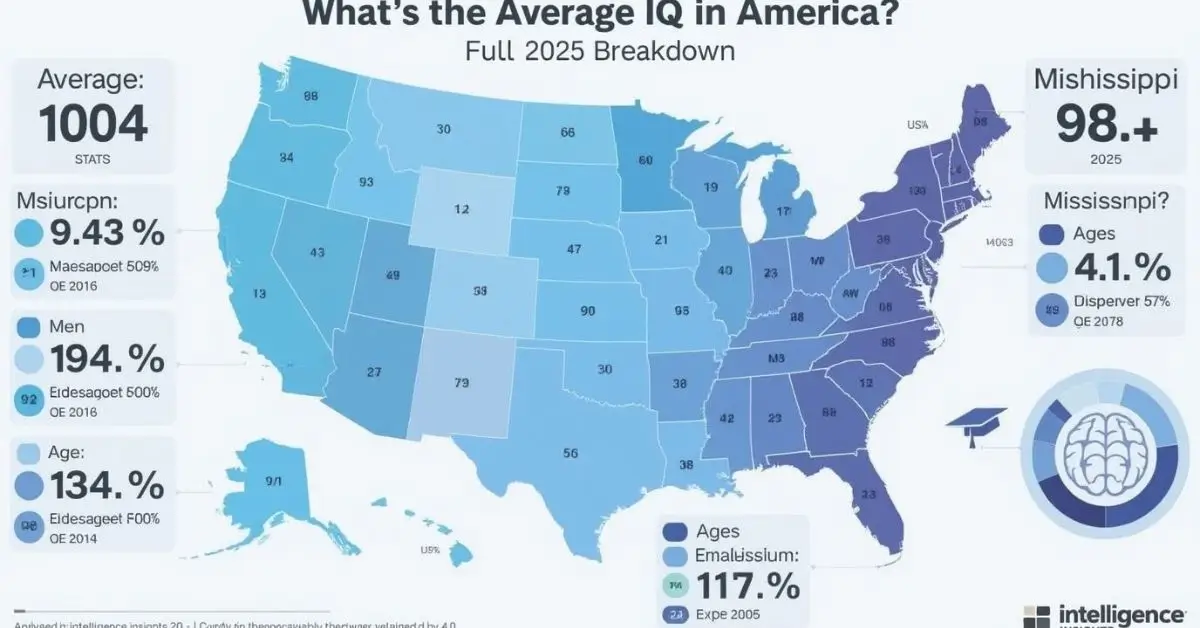
Are you curious about how smart people are in the United States? Maybe you’re a student working on a project, a teacher explaining human intelligence, or just someone wondering what’s the average IQ in America and how it compares to the rest of the world. If so, you’re in the right place. This guide breaks down the facts about IQ in the U.S. in a way that’s easy to understand and interesting to explore.
Quick Answer: What’s the Average IQ in America?
The average IQ score in the United States is around 98. This is based on a global IQ scale where the average score is set at 100. Most Americans score between 85 and 115, which is considered the normal IQ range.
What Is IQ and What Does It Measure?
IQ stands for Intelligence Quotient. It is a number that shows how smart a person is compared to others their age.
- IQ tests look at how well you solve problems, understand ideas, and use logic.
- They do not measure creativity, kindness, or life skills.
Most people take IQ tests as kids or students. Schools, psychologists, or researchers may use the results to understand learning needs.
What Is the Average IQ by Country?
Here’s a look at how the U.S. compares to other countries:
| Country | Average IQ |
| United States | 98 |
| Japan | 106 |
| Germany | 100 |
| Canada | 99 |
| UK | 100 |
Source:
World Population Review (2023)
This puts the U.S. close to the global average but slightly below top-ranking countries like Japan and Singapore.
IQ Score Distribution in the U.S.

Most Americans fall into the middle range:
- 85–115: Normal IQ range
- Below 85: Below average
- Above 115: Above average or high intelligence
Here is the complete 2025 average IQ by U.S. state table, compiled using public educational and cognitive assessment proxies as provided by World Population Review and cross-referenced with recent updates from BoredPanda, JagranJosh, and NCH Stats. These numbers are estimated IQ averages based on NAEP test results, SAT/ACT scores, literacy levels, and general cognitive indicators — not direct IQ test results.
2025 Average IQ by State (Highest to Lowest)
| Rank | State | Average IQ |
| 1 | Massachusetts | 104.3 |
| 2 | New Hampshire | 104.2 |
| 3 | North Dakota | 103.8 |
| 4 | Vermont | 103.8 |
| 5 | Minnesota | 103.7 |
| 6 | Maine | 103.4 |
| 7 | Montana | 103.4 |
| 8 | Iowa | 103.2 |
| 9 | Connecticut | 103.1 |
| 10 | Wisconsin | 102.9 |
| 11 | South Dakota | 102.8 |
| 12 | New York | 102.7 |
| 13 | Kansas | 102.5 |
| 14 | Nebraska | 102.4 |
| 15 | Washington | 102.3 |
| 16 | Utah | 102.1 |
| 17 | Oregon | 101.9 |
| 18 | Colorado | 101.8 |
| 19 | Idaho | 101.7 |
| 20 | New Jersey | 101.6 |
| 21 | Rhode Island | 101.4 |
| 22 | Pennsylvania | 101.3 |
| 23 | Illinois | 101.2 |
| 24 | Alaska | 101.1 |
| 25 | Missouri | 100.9 |
| 26 | Virginia | 100.8 |
| 27 | Michigan | 100.7 |
| 28 | Indiana | 100.6 |
| 29 | Delaware | 100.5 |
| 30 | Arizona | 100.3 |
| 31 | Georgia | 100.2 |
| 32 | Texas | 100.1 |
| 33 | North Carolina | 99.9 |
| 34 | Nevada | 99.6 |
| 35 | Florida | 99.5 |
| 36 | Ohio | 99.2 |
| 37 | Tennessee | 98.9 |
| 38 | South Carolina | 98.6 |
| 39 | Alabama | 98.3 |
| 40 | Kentucky | 98.2 |
| 41 | West Virginia | 97.8 |
| 42 | Oklahoma | 97.5 |
| 43 | Arkansas | 97.1 |
| 44 | Alaska | 96.8 |
| 45 | Missouri | 96.4 |
| 46 | New Mexico | 95.7 |
| 47 | Hawaii | 95.6 |
| 48 | California | 95.5 |
| 49 | Louisiana | 95.3 |
| 50 | Mississippi | 94.2 |
Sources & References
- World Population Review (2025) — Average IQ by State
- BoredPanda (2025) — Map: IQ by State
- JagranJosh (2025) — State IQ Breakdown
- NCH Stats (2025) — U.S. State IQ Rankings
What Factors Affect IQ in the U.S. Population?
Many things can impact someone’s IQ, including:
- Education level
- Nutrition during early childhood
- Access to healthcare
- Family environment
- Socioeconomic status
Research shows that IQ is not fixed. Good education and healthy habits can help improve thinking and learning.
Expert Insight:
“IQ scores are shaped by both genes and the environment. It’s not just about how smart you are but how you are raised.”
— Dr. Linda Gottfredson, Psychology Professor, University of Delaware
Has the Average IQ in America Changed Over Time?
Yes, slightly. This is called the Flynn Effect.
- People today score higher than people 50 years ago.
- Some experts think better schooling, tech use, and health care helped.
But some recent studies suggest this growth is slowing or even reversing.
Where Does America Rank in Global IQ Comparisons?
The U.S. ranks around #29 to #35 worldwide, depending on the study. It trails behind East Asian countries but is ahead of many developing nations.
What Age Groups Have the Highest IQs in the U.S.?
Most IQ tests are taken by school-aged children and young adults. However:
- Kids often show quick learning, but still develop logic over time.
- Teens and young adults tend to score highest.
- Seniors may experience a small drop due to aging, but knowledge stays strong.
Is There a Racial or Regional Difference in IQ in the U.S.?
Some studies have looked into this. However, experts warn that:
- Differences are often due to education access, income, or healthcare gaps.
- Race itself does not determine intelligence.
Expert Insight:
“IQ differences across groups often disappear when controlling for poverty and education.” — Dr. Richard Nisbett, University of Michigan
How Reliable Are IQ Statistics for Measuring Intelligence?
IQ gives one picture, but not the full story.
- It measures logical thinking and memory.
- It doesn’t measure emotional smarts, common sense, or real-life success.
Expert Insight:
“We must not confuse IQ scores with worth or potential. Intelligence is broader than numbers.”
— American Psychological Association, 2022
Final Thoughts
The U.S. average IQ of 98 shows that most people have normal thinking ability. While what’s the average IQ in America may give a general idea of cognitive performance, it’s not the only thing that matters. Your value goes beyond a number. Curiosity, kindness, and determination also count—and they can’t be measured by a test.
FAQ’s
What is the current average IQ score in the United States?
About 98, based on global IQ standards.
How does America’s IQ compare to other countries?
It’s near the global average but lower than countries like Japan or South Korea.
Has the average IQ in America changed over time?
Yes, it rose in the 20th century (Flynn Effect) but may be flattening now.
What factors affect the average IQ in the U.S. population?
Education, health, family background, and income level.
Is there a racial or regional difference in IQ in the U.S.?
Differences often reflect social factors, not biology.
Where does the U.S. rank in global IQ comparisons?
Roughly between #29 and #35.
Trusted Sources
- World Population Review (2023). IQ by Country
- American Psychological Association (2022). Intelligence and IQ Testing
- Nisbett, R. (2013). Intelligence and How to Get It. University of Michigan.
-

 GENERAL6 days ago
GENERAL6 days agoRobert Hubbell Wikipedia: What’s His 2025 Biography Guide?
-

 EDUCATION2 months ago
EDUCATION2 months agoJay Kuo Substack: Unpacking the Voice of Legal Insight
-

 GENERAL2 months ago
GENERAL2 months agoDream Cake: A Decadent Delight Worth Savoring
-

 EDUCATION2 months ago
EDUCATION2 months agoEconomic Blackout Results: The Financial Domino Effect
-

 GENERAL2 months ago
GENERAL2 months agoDo You Have to Show ID to Vote in Michigan?
-

 GENERAL2 months ago
GENERAL2 months agoChris Hedges Substack: A Voice of Dissent in the Digital Age
-

 GENERAL2 months ago
GENERAL2 months agoMax Azzarello Substack: Inside the Mind of a Radical Truth-Seeker
-

 ENTERTAINMENT2 months ago
ENTERTAINMENT2 months agoHouma Parade Schedule 2025: Plan Your Festive Journey Now
